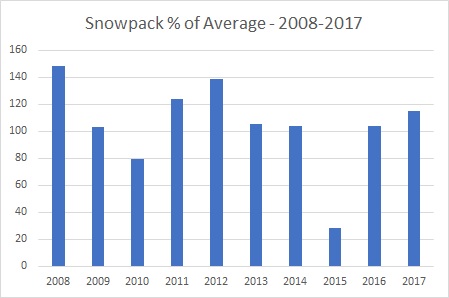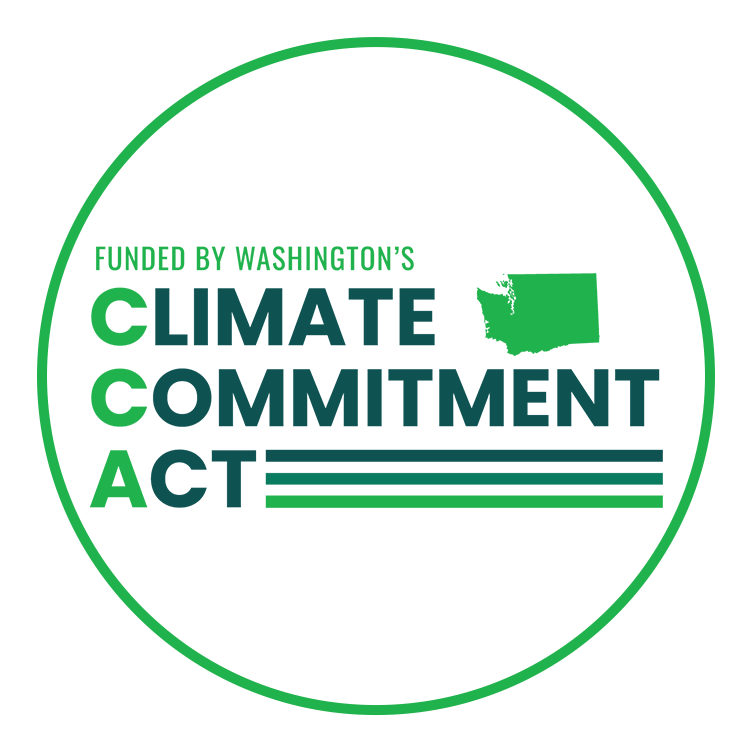Washington Snowpack Again Above Average
It is one of the most common claims about the impact of climate change in the Pacific Northwest – the threat that our snowpack will decline, harming recreation, water supply, farmers and fish. Just last week on March 31, in a piece titled, “Climate change is not in the future but is here and now,” a UW professor pointed to the claim that “our mountain snowpack is reduced by an increasingly earlier spring and later fall.”
Actual snowpack data, however, contradict this oft-repeated claim.
 Although snowpack fluctuates during the winter, the percentages on April 1 are a useful guide to gauging water supply for the summer. Including 2017, snowpack on April 1 has been higher than average in eight of the last ten years.
Although snowpack fluctuates during the winter, the percentages on April 1 are a useful guide to gauging water supply for the summer. Including 2017, snowpack on April 1 has been higher than average in eight of the last ten years.
If climate change is “here and now,” it isn’t showing up in our snowpack. This isn’t just one or two years. It is eight of the last ten.
Some may argue that ten years isn’t long enough to see the impacts. That may be, but we can’t point to snowpack as evidence of climate change today when snowpack is above average most of the time.
Additionally, there isn’t evidence of high temperatures turning snow into rain on a regular basis. By comparing the amount of snow and rain compared to normal, we can see if what is causing high snowpack is heavy precipitation but a lower-then-normal amount falling as snow, or that temperature isn't high enough to reduce snowpack. For example, this last winter, snowpack was 115 percent of normal, but precipitation was even higher, at 126 percent. This indicates that even though we had higher-than-average snowpack, it was driven in part by overall higher precipitation rather than cool temperatures.
That trend, however, doesn’t hold over the ten years. In six of the ten years, the percentage of precipitation that fell as snow was higher than average. For example, in 2009 and 2014, we had lower-than-average overall precipitation, but higher-than-average snowpack. There are other reasons snowpack on March 31 could be higher than average while precipitation lagged, but the fact that six of the ten years were like that indicates a very weak, or nonexistent, warming influence.
There are two important lessons from this data.
First, we should be less certain about the impacts we will see in the future. Several local scientists and advocates say we are already seeing declining snowpack as a result of global warming, even as the data show otherwise. Policymakers, looking to scientists for confident predictions about future impacts, should build in more uncertainty than scientists may be willing to admit.
Second, there is a strong incentive to continue to tell alarmist stories even when they are not true. Former Seattle Mayor Greg Nickels told the Seattle Times in 2005, that “we’d never see normal snowpack again.” He was wrong. We’ve seen more above normal snowpack years since then than below. And yet, declining snowpack continues to be one of the first impacts mentioned by those pushing for new carbon regulations, more subsidies and aggressive climate policy.
There is a strong push in Washington state to lock in dramatic and expensive climate policies. The failure to accurately predict something as relatively simple as snowpack should be a warning to policymakers who want to get the solution right without sacrificing economic growth or other public priorities. Given the uncertainty about climate impacts, we should avoid policies that are expensive and inflexible. The harm may be greater than the benefit.





